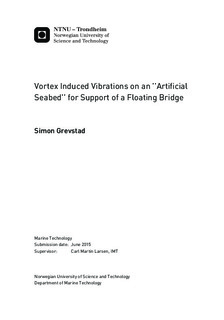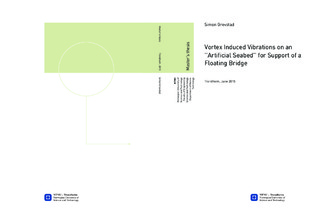| dc.description.abstract | The engineering company Reinertsen is planning a floating bridge with tunnel
that will go across the Sognefjord. Reinertsen has designed what they call
an "artificial seabed" to be used for anchoring of the floating bridge. The
subsea company Deepocean is hired by Reinertsen to look at the installation
possibilites of this construction. It is of Deepoceans and Reinertsens interest
to see how vortex induced vibrations (VIV) may affect the artificial seabed.
The main objectives of this master thesis have been to do VIV calculations
on the artificial seabed when modeled as connected to and detached from
the floating bridge and tunnel. The calculations were done in the software
VIVANA developed at MARINTEK.
The artificial seabed is made of two main bundles each consisting of three pipes. To get realistic hydrodynamic data for a bundle with three pipes, model experiments were conducted in the Marine Cybernetics Laboratory at NTNU. The model experiments were also one of the main objectives in this thesis.
The model experiments were done using forced vibrations in a tank filled with water. The model was mounted to a yoke and carriage system programmed to run the model with constant velocity through the tank. Both pure cross-flow and combined in-line/cross-flow tests were done. Three different orientations of the bundle relative to the current flow were used. The
results of the experiments were excitation, added mass, drag and lift coefficients. The Strouhals number was also calculated for each orientation.
The results from the combined in-line/cross-flow tests showed that VIV will not occur for the combinations of phase angles and amplitudes used in the experiments.
Pure cross-flow analyses were done in VIVANA using the hydrodynamic coefficients found from the experiments. The shortest fatigue life found for the case where the articial seabed model was assumed connected to the floating bridge was 0.23919 * 10^6 years. For the cases where the articial seabed model was assumed detached from the floating bridge and tunnel, the
shortest fatigue life was found to be 0.24240 * 10^^6 years. The large fatigue life
implies that vortex induced vibrations will not be a problem to the artificial
seabed. The results are however uncertain due to the limitations of the study. | |

